附录 1 外文原文
Introducing the Spring Framework
The Spring Framework: a popular open source application framework that
addresses many of the issues outlined in this book. This chapter will introduce the
basic ideas of Spring and dis-cuss the central “bean factory” lightweight
Inversion-of-Control (IoC) container in detail.
Spring makes it particularly easy to implement lightweight, yet extensible, J2EE
archi-tectures. It provides an out-of-the-box implementation of the fundamental
architectural building blocks we recommend. Spring provides a consistent way of
structuring your applications, and provides numerous middle tier features that can
make J2EE development significantly easier and more flexible than in traditional
approaches.
The basic motivations for Spring are:
To address areas not well served by other frameworks. There are numerous good
solutions to specific areas of J2EE infrastructure: web frameworks, persistence
solutions, remoting tools, and so on. However, integrating these tools into a
comprehensive architecture can involve significant effort, and can become a burden.
Spring aims to provide an end-to-end solution, integrating spe-cialized frameworks
into a coherent overall infrastructure. Spring also addresses some areas that other
frameworks don’t. For example, few frameworks address generic transaction
management, data access object implementation, and gluing all those things together
into an application, while still allowing for best-of-breed choice in each area. Hence
we term Spring an application framework, rather than a web framework, IoC or AOP
framework, or even middle tier framework.
To allow for easy adoption. A framework should be cleanly layered, allowing the
use of indi-vidual features without imposing a whole world view on the application.
Many Spring features, such as the JDBC abstraction layer or Hibernate integration,
can be used in a library style or as part of the Spring end-to-end solution.
�
To deliver ease of use. As we’ve noted, J2EE out of the box is relatively hard to
use to solve many common problems. A good infrastructure framework should make
simple tasks simple to achieve, without forcing tradeoffs for future complex
requirements (like distributed transactions) on the application developer. It should
allow developers to leverage J2EE services such as JTA where appropriate, but to
avoid dependence on them in cases when they are unnecessarily complex.
To make it easier to apply best practices. Spring aims to reduce the cost of
adhering to best practices such as programming to interfaces, rather than classes,
almost to zero. However, it leaves the choice of architectural style to the developer.
Non-invasiveness. Application objects should have minimal dependence on the
framework. If leveraging a specific Spring feature, an object should depend only on
that particular feature, whether by implementing a callback interface or using the
framework as a class library. IoC and AOP are the key enabling technologies for
avoiding framework dependence.
Consistent configuration. A good infrastructure framework should keep
application configuration flexible and consistent, avoiding the need for custom
singletons and factories. A single style should be applicable to all configuration needs,
from the middle tier to web controllers.
Ease of testing. Testing either whole applications or individual application
classes in unit tests should be as easy as possible. Replacing resources or application
objects with mock objects should be straightforward.
To allow for extensibility. Because Spring is itself based on interfaces, rather
than classes, it is easy to extend or customize it. Many Spring components use
strategy interfaces, allowing easy customization.
A Layered Application Framework
Chapter 6 introduced the Spring Framework as a lightweight container,
competing with IoC containers such as PicoContainer. While the Spring lightweight
container for JavaBeans is a core concept, this is just the foundation for a solution for
�
all middleware layers.
Basic Building Blocks
pring is a full-featured application framework that can be leveraged at many
levels. It consists of multi-ple sub-frameworks that are fairly independent but still
integrate closely into a one-stop shop, if desired. The key areas are:
Bean factory. The Spring lightweight IoC container, capable of configuring and
wiring up Java-Beans and most plain Java objects, removing the need for custom
singletons and ad hoc configura-tion. Various out-of-the-box implementations include
an XML-based bean factory. The lightweight IoC container and its Dependency
Injection capabilities will be the main focus of this chapter.
Application context. A Spring application context extends the bean factory
concept by adding support for message sources and resource loading, and providing
hooks into existing environ-ments. Various out-of-the-box implementations include
standalone application contexts and an XML-based web application context.
AOP framework. The Spring AOP framework provides AOP support for method
interception on any class managed by a Spring lightweight container. It supports easy
proxying of beans in a bean factory, seamlessly weaving in interceptors and other
advice at runtime. Chapter 8 dis-cusses the Spring AOP framework in detail. The
main use of the Spring AOP framework is to provide declarative enterprise services
for POJOs.
Auto-proxying. Spring provides a higher level of abstraction over the AOP
framework and low-level services, which offers similar ease-of-use to .NET within a
J2EE context. In particular, the provision of declarative enterprise services can be
driven by source-level metadata.
Transaction management. Spring provides a generic transaction management
infrastructure, with pluggable transaction strategies (such as JTA and JDBC) and
various means for demarcat-ing transactions in applications. Chapter 9 discusses its
rationale and the power and flexibility that it offers.
�
JDBC support. Spring offers two levels of JDBC abstraction that significantly
ease the effort of writing JDBC-based DAOs: the org.springframework.jdbc.core
package (a template/
callback approach) and the org.springframework.jdbc.object package (modeling
RDBMS operations as reusable objects). Using the Spring JDBC packages can deliver
much greater pro-ductivity and eliminate the potential for common errors such as
leaked connections, compared with direct use of JDBC. The Spring JDBC abstraction
integrates with the transaction and DAO abstractions.
Integration with O/R mapping tools. Spring provides support classes for O/R
Mapping tools like Hibernate, JDO, and iBATIS Database Layer to simplify resource
setup, acquisition, and release, and to integrate with the overall transaction and DAO
abstractions. These integration packages allow applications to dispense with custom
ThreadLocal sessions and native transac-tion handling, regardless of the underlying
O/R mapping approach they work with.
Web MVC framework. Spring provides a clean implementation of web MVC,
consistent with the JavaBean configuration approach. The Spring web framework
enables web controllers to be configured within an IoC container, eliminating the need
to write any custom code to access business layer services. It provides a generic
DispatcherServlet and out-of-the-box controller classes for command and form
handling. Request-to-controller mapping, view resolution, locale resolution and other
important services are all pluggable, making the framework highly extensi-ble. The
web framework is designed to work not only with JSP, but with any view technology,
such as Velocity—without the need for additional bridges. Chapter 13 discusses web
tier design and the Spring web MVC framework in detail.
Remoting support. Spring provides a thin abstraction layer for accessing remote
services without hard-coded lookups, and for exposing Spring-managed application
beans as remote services. Out-of-the-box support is included for RMI, Caucho’s
Hessian and Burlap web service protocols, and WSDL Web Services via JAX-RPC.
Chapter 11 discusses lightweight remoting.
While Spring addresses areas as diverse as transaction management and web
�
MVC, it uses a consistent approach everywhere. Once you have learned the basic
configuration style, you will be able to apply it in many areas. Resources, middle tier
objects, and web components are all set up using the same bean configuration
mechanism. You can combine your entire configuration in one single bean definition
file or split it by application modules or layers; the choice is up to you as the
application developer. There is no need for diverse configuration files in a variety of
formats, spread out across the application.
Spring on J2EE
Although many parts of Spring can be used in any kind of Java environment, it is
primarily a J2EE application framework. For example, there are convenience classes
for linking JNDI resources into a bean factory, such as JDBC DataSources and EJBs,
and integration with JTA for distributed transaction management. In most cases,
application objects do not need to work with J2EE APIs directly, improving
reusability and meaning that there is no need to write verbose, hard-to-test, JNDI
lookups.
Thus Spring allows application code to seamlessly integrate into a J2EE
environment without being unnecessarily tied to it. You can build upon J2EE services
where it makes sense for your application, and choose lighter-weight solutions if there
are no complex requirements. For example, you need to use JTA as transaction
strategy only if you face distributed transaction requirements. For a single database,
there are alternative strategies that do not depend on a J2EE container. Switching
between those transac-tion strategies is merely a matter of configuration; Spring’s
consistent abstraction avoids any need to change application code.
Spring offers support for accessing EJBs. This is an important feature (and
relevant even in a book on “J2EE without EJB”) because the use of dynamic proxies
as codeless client-side business delegates means that Spring can make using a local
stateless session EJB an implementation-level, rather than a fundamen-tal
architectural, choice. Thus if you want to use EJB, you can within a consistent
architecture; however, you do not need to make EJB the cornerstone of your
�
architecture. This Spring feature can make devel-oping EJB applications significantly
faster, because there is no need to write custom code in service loca-tors or business
delegates. Testing EJB client code is also much easier, because it only depends on the
EJB’s Business Methods interface (which is not EJB-specific), not on JNDI or the
EJB API.
Spring also provides support for implementing EJBs, in the form of convenience
superclasses for EJB implementation classes, which load a Spring lightweight
container based on an environment variable specified in the ejb-jar.xml deployment
descriptor. This is a powerful and convenient way of imple-menting SLSBs or MDBs
that are facades for fine-grained POJOs: a best practice if you do choose to implement
an EJB application. Using this Spring feature does not conflict with EJB in any way—
it merely simplifies following good practice.
Introducing the Spring Framework
The main aim of Spring is to make J2EE easier to use and promote good
programming practice. It does not reinvent the wheel; thus you’ll find no logging
packages in Spring, no connection pools, no distributed transaction coordinator. All
these features are provided by other open source projects—such as Jakarta Commons
Logging (which Spring uses for all its log output), Jakarta Commons DBCP (which
can be used as local DataSource), and ObjectWeb JOTM (which can be used as
transaction manager)—or by your J2EE application server. For the same reason,
Spring doesn’t provide an O/R mapping layer: There are good solutions for this
problem area, such as Hibernate and JDO.
Spring does aim to make existing technologies easier to use. For example,
although Spring is not in the business of low-level transaction coordination, it does
provide an abstraction layer over JTA or any other transaction strategy. Spring is also
popular as middle tier infrastructure for Hibernate, because it provides solutions to
many common issues like SessionFactory setup, ThreadLocal sessions, and exception
handling. With the Spring HibernateTemplate class, implementation methods of
Hibernate DAOs can be reduced to one-liners while properly participating in
transactions.
�
The Spring Framework does not aim to replace J2EE middle tier services as a
whole. It is an application framework that makes accessing low-level J2EE container
ser-vices easier. Furthermore, it offers lightweight alternatives for certain J2EE
services in some scenarios, such as a JDBC-based transaction strategy instead of JTA
when just working with a single database. Essentially, Spring enables you to write
appli-cations that scale down as well as up.
Spring for Web Applications
A typical usage of Spring in a J2EE environment is to serve as backbone for the
logical middle tier of a J2EE web application. Spring provides a web application
context concept, a powerful lightweight IoC container that seamlessly adapts to a web
environment: It can be accessed from any kind of web tier, whether Struts, WebWork,
Tapestry, JSF, Spring web MVC, or a custom solution.
The following code shows a typical example of such a web application context.
In a typical Spring web app, an applicationContext.xml file will reside in the
WEB-INF directory, containing bean defini-tions according to the “spring-beans”
DTD. In such a bean definition XML file, business objects and resources are defined,
for example, a “myDataSource” bean, a “myInventoryManager” bean, and a
“myProductManager” bean. Spring takes care of their configuration, their wiring up,
and their lifecycle.
com.mysql.jdbc.
Driver
jdbc:mysql:myds
�[
][ ]
true
By default, all such beans have “singleton” scope: one instance per context.
The “myInventoryManager” bean will automatically be wired up with the defined
DataSource, while “myProductManager” will in turn receive a reference to the
“myInventoryManager” bean. Those objects (traditionally called “beans” in
Spring terminology) need to expose only the corresponding bean properties or
constructor arguments (as you’ll see later in this chapter); they do not have to perform
any custom lookups.
A root web application context will be loaded by a ContextLoaderListener that is
defined in web.xml as follows:
org.springframework.web.context.ContextLoaderListener
...
After initialization of the web app, the root web application context will be
available as a ServletContext attribute to the whole web application, in the usual
manner. It can be retrieved from there easily via fetching the corresponding attribute,
or via a convenience method in org.springframework.web.
context.support.WebApplicationContextUtils. This means that the application context
will be available in any web resource with access to the ServletContext, like a Servlet,
�
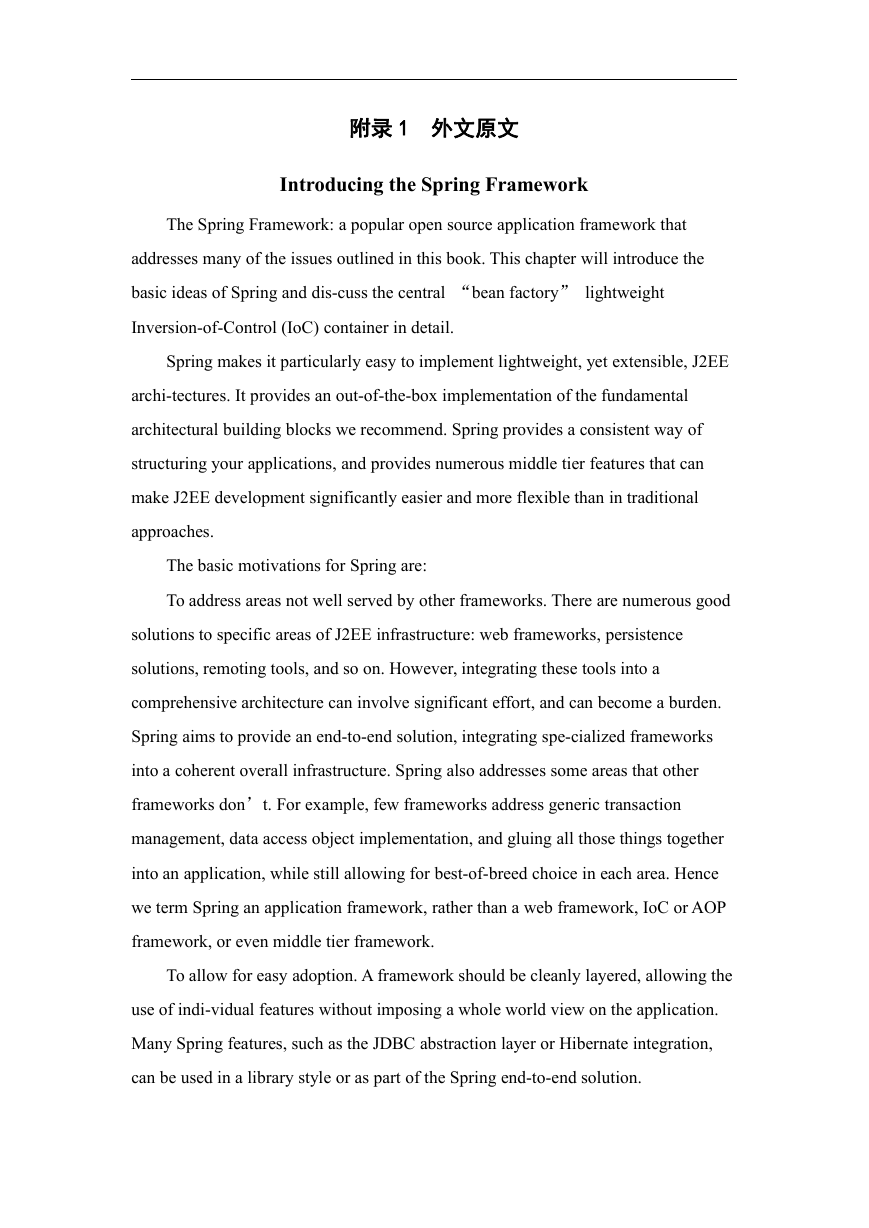
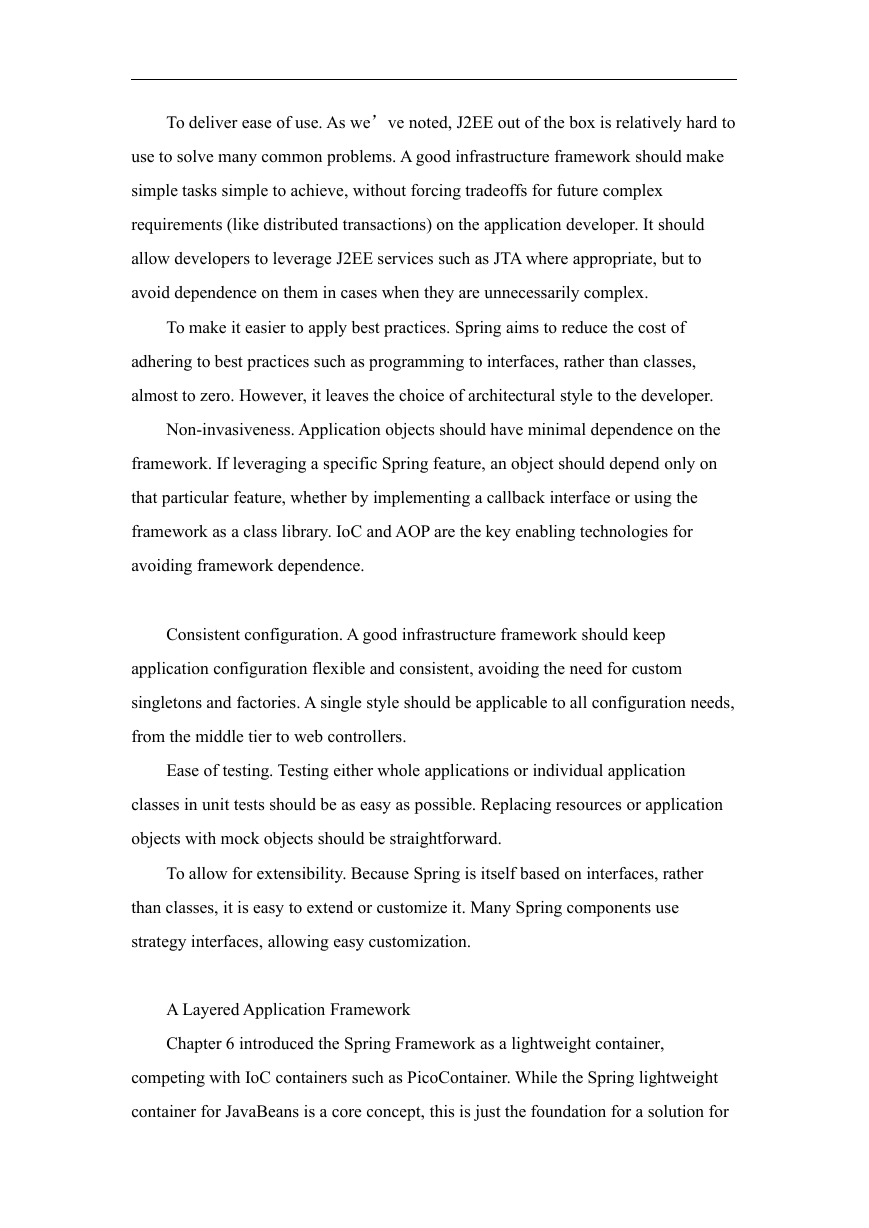
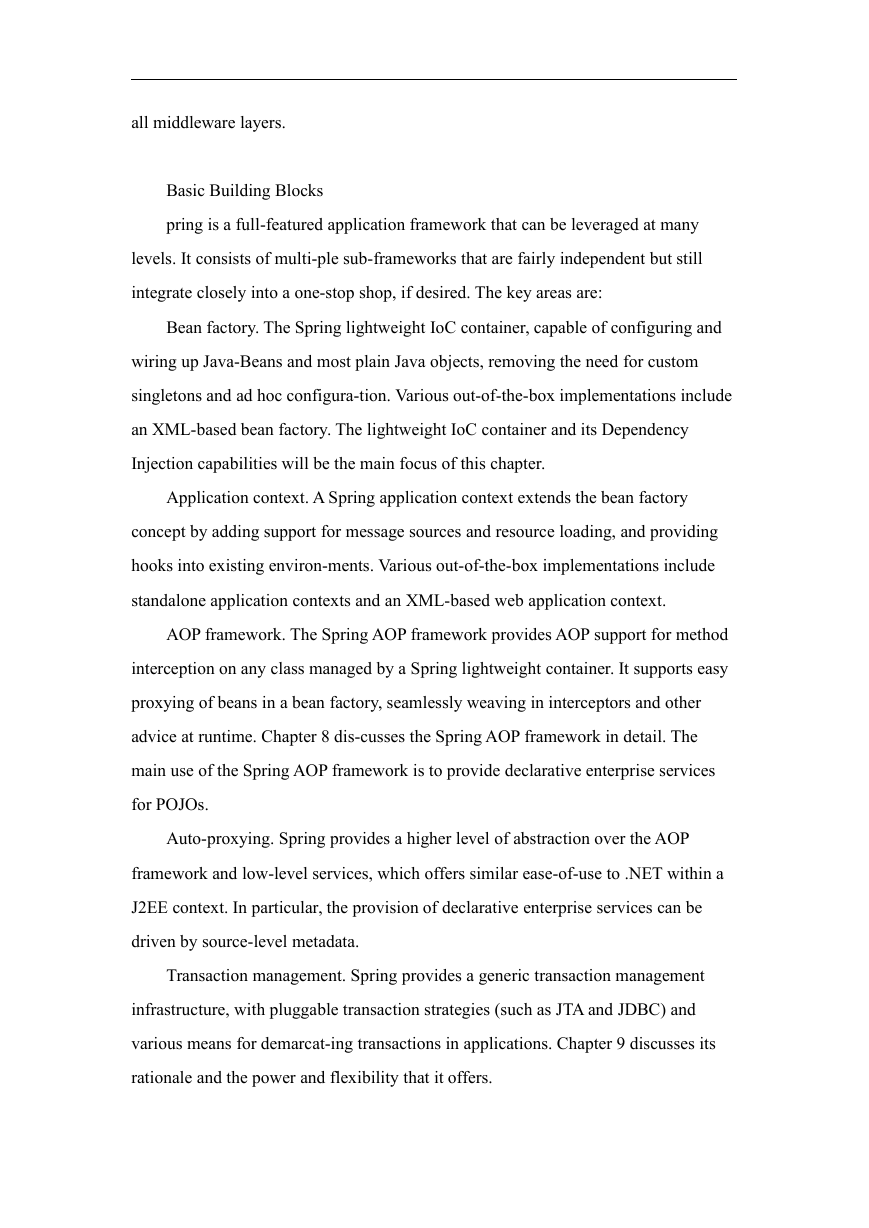
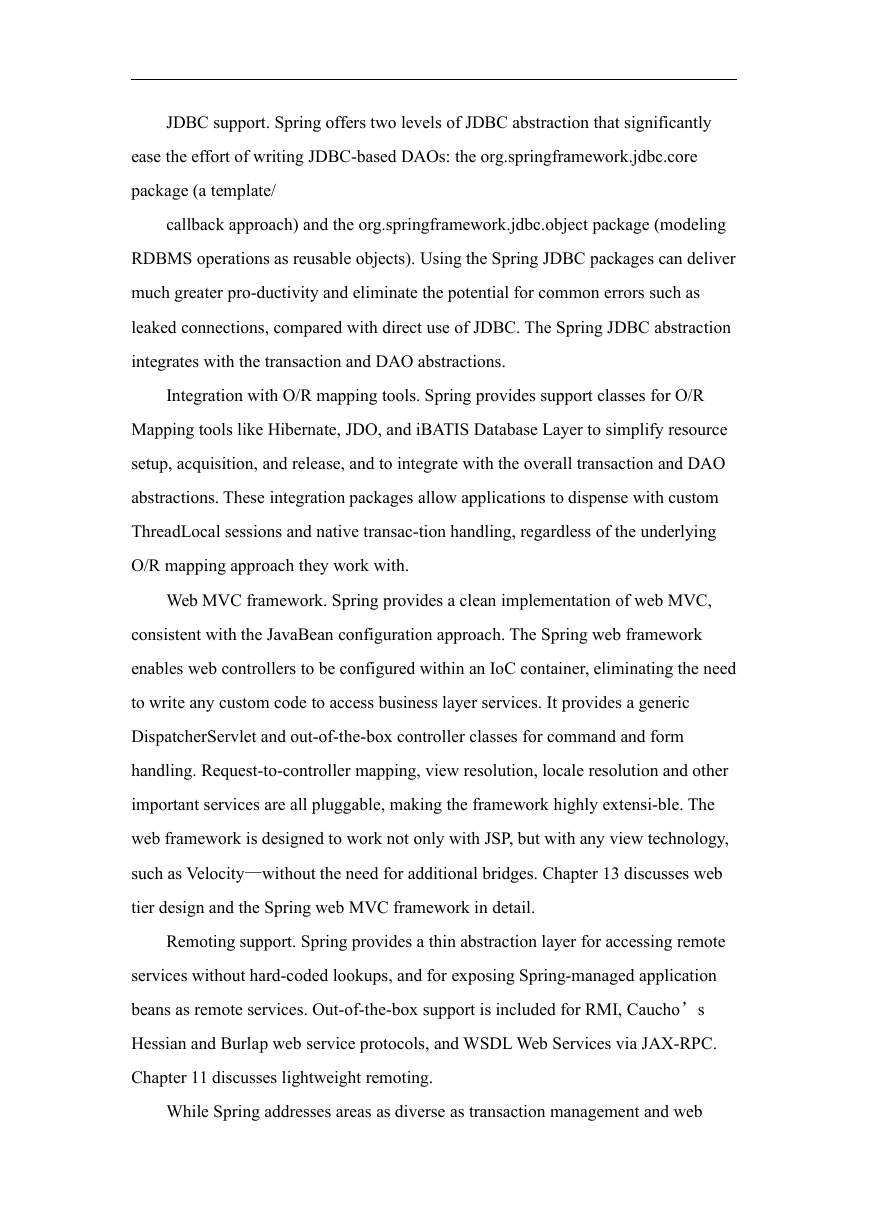
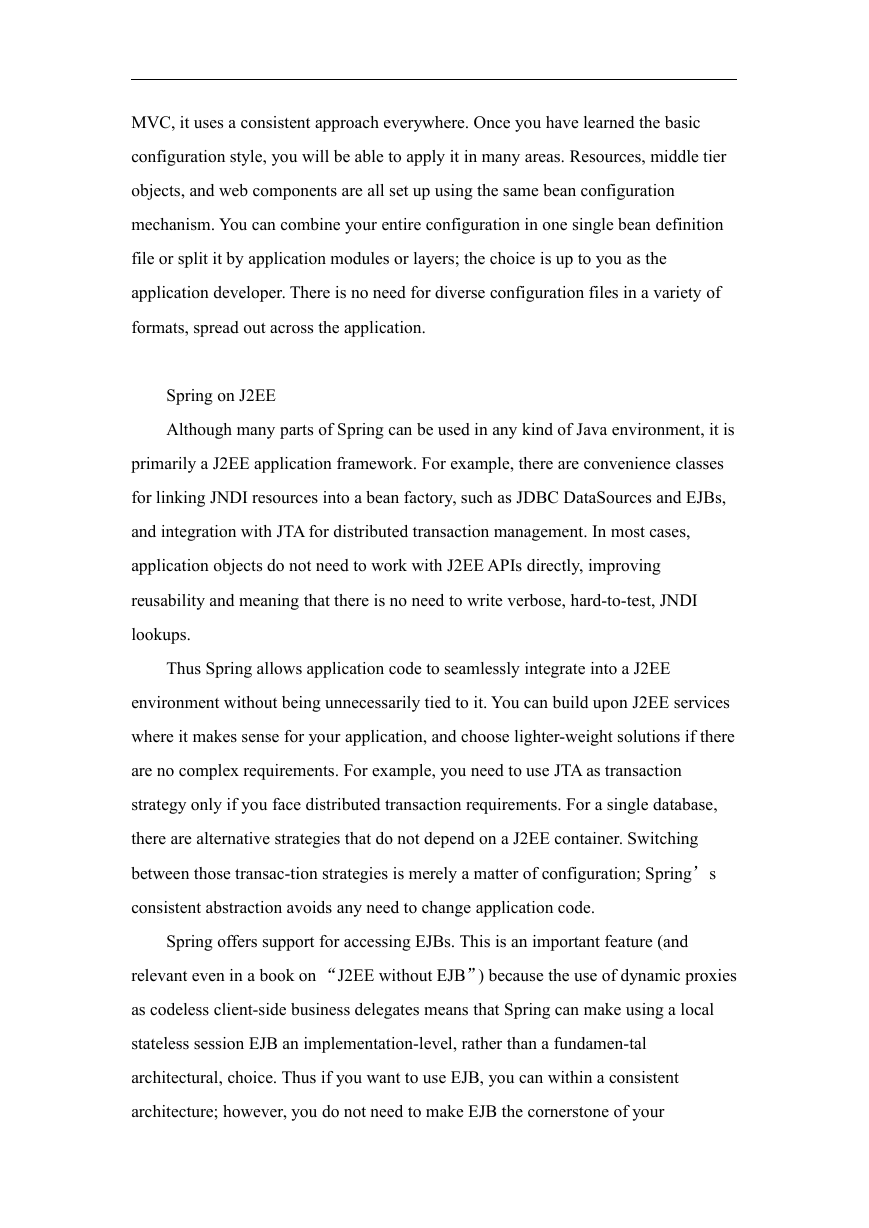
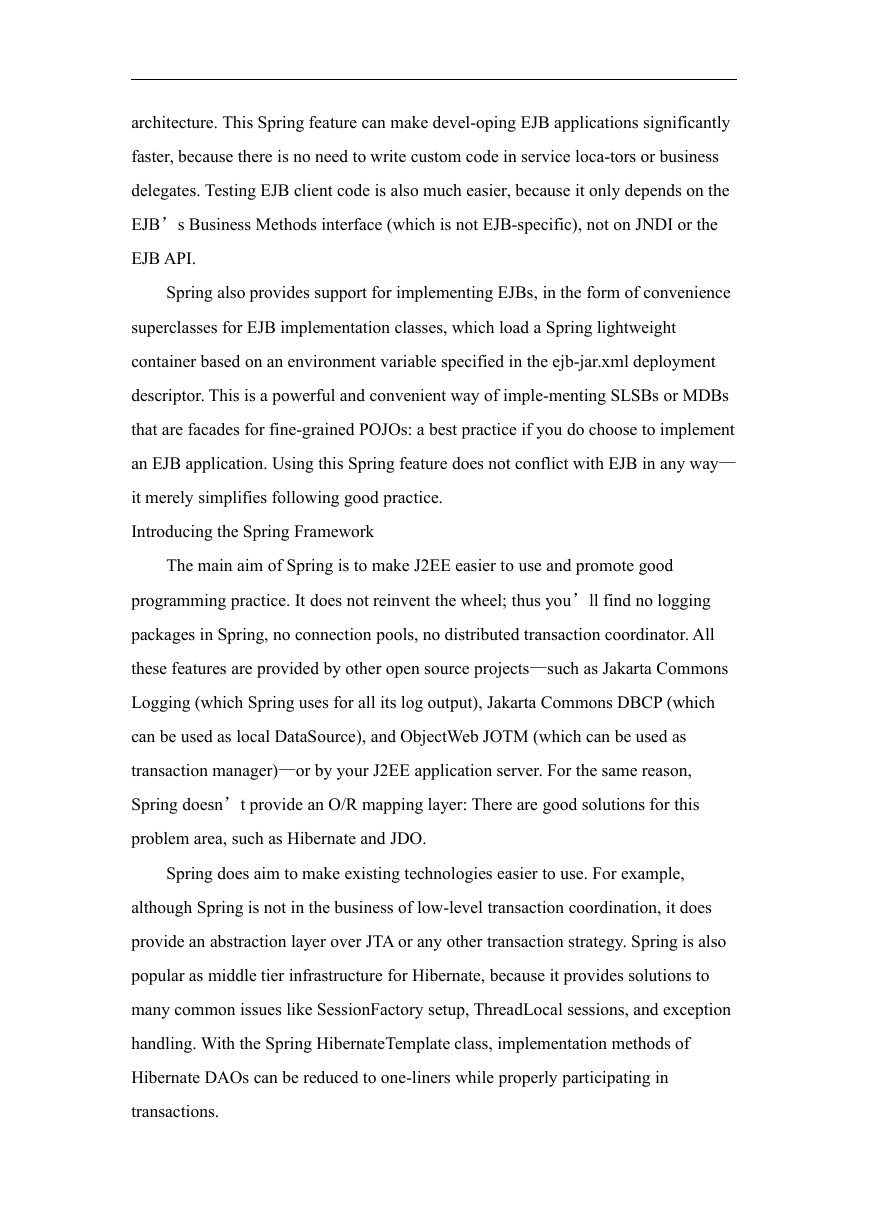
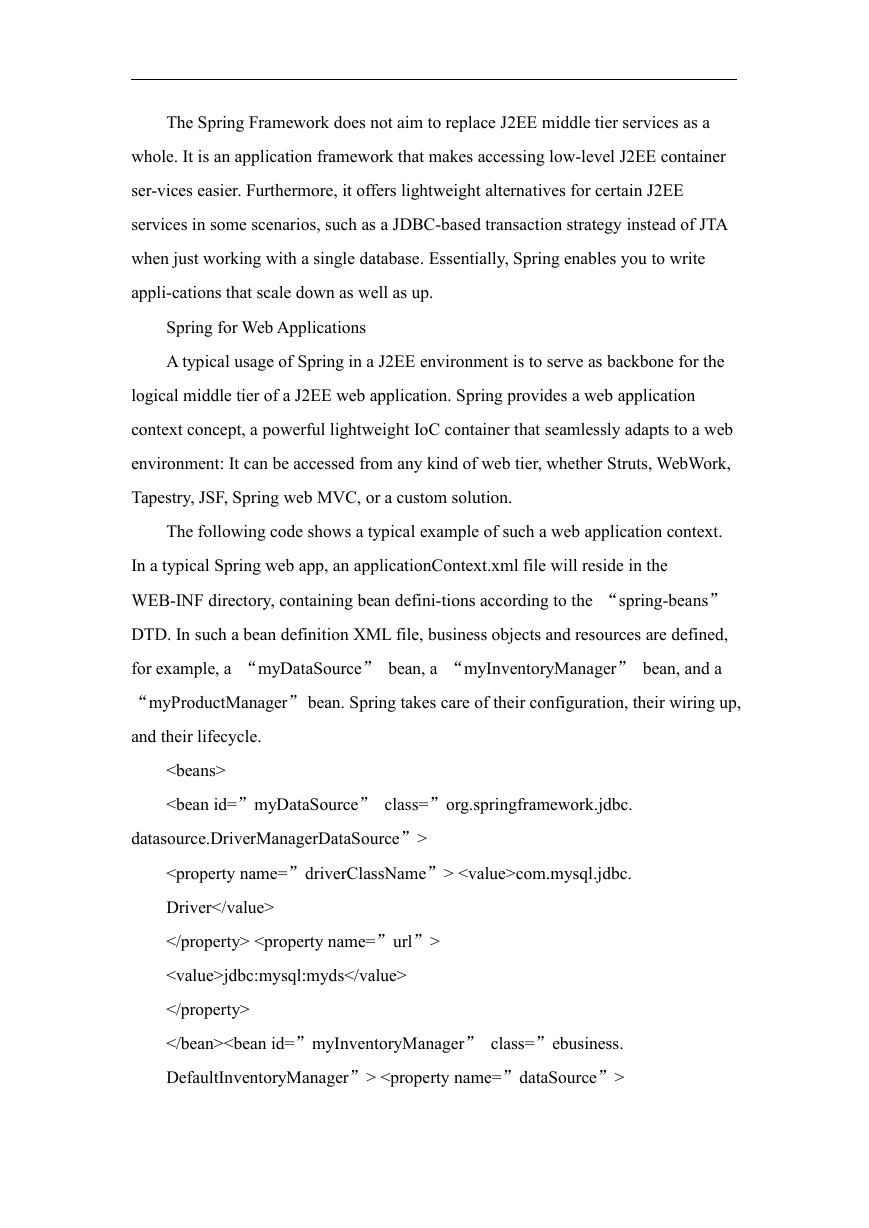
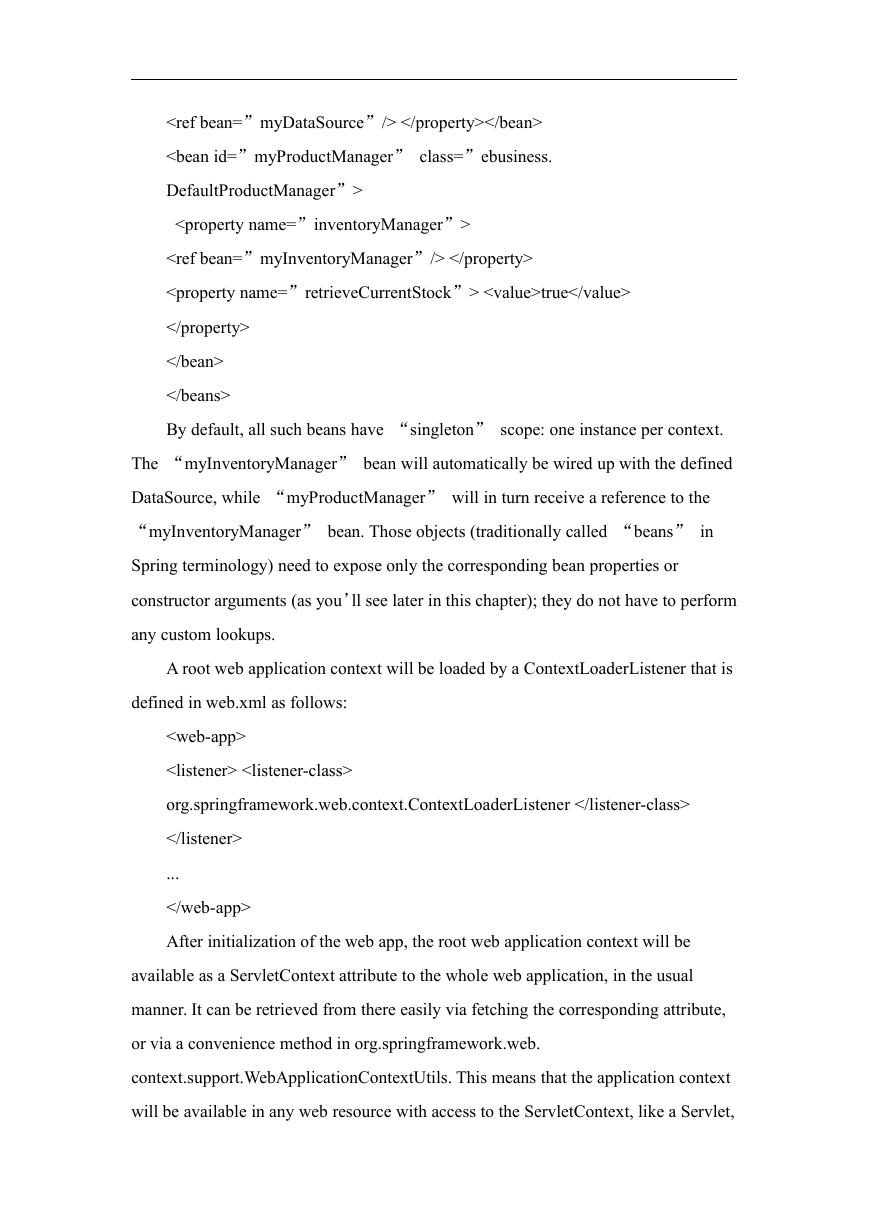








 2023年江西萍乡中考道德与法治真题及答案.doc
2023年江西萍乡中考道德与法治真题及答案.doc 2012年重庆南川中考生物真题及答案.doc
2012年重庆南川中考生物真题及答案.doc 2013年江西师范大学地理学综合及文艺理论基础考研真题.doc
2013年江西师范大学地理学综合及文艺理论基础考研真题.doc 2020年四川甘孜小升初语文真题及答案I卷.doc
2020年四川甘孜小升初语文真题及答案I卷.doc 2020年注册岩土工程师专业基础考试真题及答案.doc
2020年注册岩土工程师专业基础考试真题及答案.doc 2023-2024学年福建省厦门市九年级上学期数学月考试题及答案.doc
2023-2024学年福建省厦门市九年级上学期数学月考试题及答案.doc 2021-2022学年辽宁省沈阳市大东区九年级上学期语文期末试题及答案.doc
2021-2022学年辽宁省沈阳市大东区九年级上学期语文期末试题及答案.doc 2022-2023学年北京东城区初三第一学期物理期末试卷及答案.doc
2022-2023学年北京东城区初三第一学期物理期末试卷及答案.doc 2018上半年江西教师资格初中地理学科知识与教学能力真题及答案.doc
2018上半年江西教师资格初中地理学科知识与教学能力真题及答案.doc 2012年河北国家公务员申论考试真题及答案-省级.doc
2012年河北国家公务员申论考试真题及答案-省级.doc 2020-2021学年江苏省扬州市江都区邵樊片九年级上学期数学第一次质量检测试题及答案.doc
2020-2021学年江苏省扬州市江都区邵樊片九年级上学期数学第一次质量检测试题及答案.doc 2022下半年黑龙江教师资格证中学综合素质真题及答案.doc
2022下半年黑龙江教师资格证中学综合素质真题及答案.doc